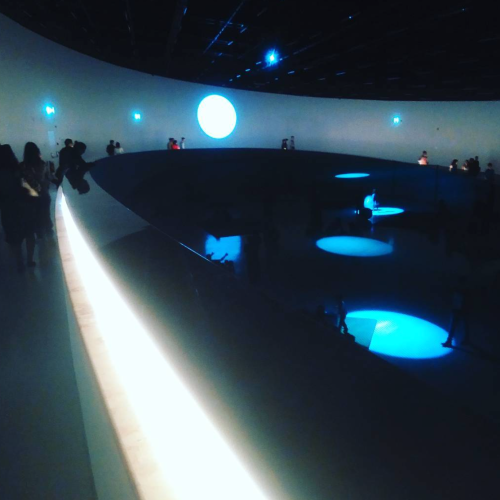Between the Beach and a Hard Place*
I’ve recently visited one of those summer music festivals in which youth is given a “free zone” to let off steam. Except for the upper floors of the sponsors’ VIP lounges, the beautiful landscape around was hidden from view by way of advertising panels, much like in Terry Gilliam’s Brazil. Youngsters received a wristband with an electronic chip so as to record their booze consumption. Drones blinked around silently. The sophisticated urbanism of the grounds reminded me of refugee camps in which city life is quickly recreated. One could look at this fenced universe as just another benign festivity, or as an expression of a dystopian apparatus that has been insidiously making its way into the most common aspects of our everyday life.
Dominique Gonzalez-Foerster typically makes us aware of hidden meanings in apparently innocent environments. In the first site-specific commission for the new MAAT building, in the context of an inaugural program addressing Utopia/Dystopia, the artist offers us a fictional setting for an alien species to observe humans. Hinting at Lisbon’s easy-going lifestyle, the place looks like an artificial beach. Yet, spectators are soon caught in a performance that rather suggests the camps in which humans have been regularly amassed. Between a rock and a hard place, the artwork presents a critical dilemma. Between the escapism of a beach and the tension of a fenced camp, several possibilities lay ahead of us – but none seems ultimately tenable.
This is the small text I contributed to the Pynchon Park publication, released on occasion of the large environment created by Dominique Gonzalez-Foerster for the opening of MAAT’s new building.
 Pynchon Park by carlos.h.reis, via Instagram.
Pynchon Park by carlos.h.reis, via Instagram.
In her piece, Dominique captures very well the duality of our times, where dystopic forms of entertainment – from distorted theme parks to recent young adult Hollywood blockbusters – continue to provide the metaphors for our worst fears, as well as a form of escapism to what is now called ‘the perfect storm.’
After 150 years it was first uttered, the term dystopia has become a household companion. That is in itself revealing. However, while being mostly a fictional device, the concept also delivers a theoretical tool to struggle with what is going seriously wrong in our societies.
Coming back to Portugal, I reencountered some of the mildly dystopian characteristics that are now typical of an old and ageing European country – issues that can’t possibly be changed in the course of one political mandate, or the four years I was away.
Amidst the excitement and buzz that make Lisbon 2.0 so attractive – including very lucrative music festivals to which thousands of young tourists flock every year – Portugal is still tarnished by the decaying dominance of a few rich families, the average mediocrity of political and economic elites, the growing social inequality, the low productivity of most labor force, and last but not least, a sort of desperate and overarching nepotism in the face of a widespread lack of job opportunities.
It gives me intense pain to refuse one interesting resumé after the other, even if my small museum team is overworked and, at the rate of 18 exhibitions a year, will be burnt out in one year or two. The most I can offer is a paid internship, which always reminds me of one of the funniest and sharpest artwork series exhibited at this year’s Manifesta.
 Artwork by my colleague at MoMA, Pablo Helguera, for Manifesta 11.
Artwork by my colleague at MoMA, Pablo Helguera, for Manifesta 11.
Look at Tuk-Tuk drivers around Lisbon and not only are they good looking, they also have Master’s degrees. Others, not so lucky to be outdoors, are buried in call centers. Youth unemployment thrives as much as in Spain or Greece, currently at nearly 30%. If novelist Cormac McCarthy suggested the US is ‘no country for old men’, Portugal is certainly not a country for young people.
Alas, the Portuguese state invests heavily in the education of these young people, with university fees as low as $1500 a year. But then, it practically hands out this highly qualified labor force to countries that are already economically ahead. The most educated generation ever in the history of the country is pushed away, forced to emigrate to Germany or the UK. How stupid can that be?
Sure, things must change, and things can change. We can take advantage of a tourist boom, without necessarily falling into the plights of Barcelonization. We have to promote entrepreneurship, although this is difficult in a country where a public service career – and, if possible, the petty corruption that comes with it – is still considered the safe way up and out.
Portuguese authorities must understand that what we are doing to our educated young adults is atrocious. Dystopian indeed.
In face of this, does the country want to be as avant-garde as some of its cultural institutions? Look at the way the world is transforming (art world included), think of the great stagnation coming ahead, and start immediately discussing the 20-hour working week. It’s the only way everyone will get its share of work and opportunities towards a better society.

Pingback: Lisboa 2.0 | shrapnel contemporary
Compelling comments indeed. This situation will be more exacerbated in the next few decades when we see more diverless cars, robots (automation) and so on…
Pingback: On Fire | shrapnel contemporary